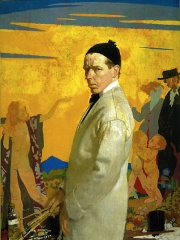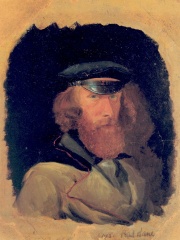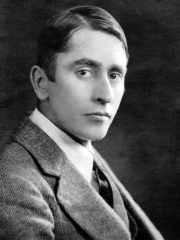



The Most Famous
PAINTERS from Ireland
This page contains a list of the greatest Irish Painters. The pantheon dataset contains 2,023 Painters, 5 of which were born in Ireland. This makes Ireland the birth place of the 43rd most number of Painters behind Azerbaijan, and Egypt.
Top 5
The following people are considered by Pantheon to be the most legendary Irish Painters of all time. This list of famous Irish Painters is sorted by HPI (Historical Popularity Index), a metric that aggregates information on a biography's online popularity.

1. Francis Bacon (1909 - 1992)
With an HPI of 75.31, Francis Bacon is the most famous Irish Painter. His biography has been translated into 62 different languages on wikipedia.
Francis Bacon (28 October 1909 – 28 April 1992) was an Irish-born British figurative painter known for his raw, unsettling imagery. Focusing on the human form, his subjects included crucifixions, portraits of popes, self-portraits, and portraits of close friends, with abstracted figures sometimes isolated in geometrical structures. He said that he saw images "in series", and his work, which numbers in the region of 590 extant paintings along with many others he destroyed, typically focused on a single subject for sustained periods, often in triptych or diptych formats. His output can be broadly described as sequences or variations on single motifs; including the 1930s Picasso-influenced bio-morphs and Furies, the 1940s male heads isolated in rooms or geometric structures, the 1950s "screaming popes," the mid-to-late 1950s animals and lone figures, the early 1960s crucifixions, the mid-to-late 1960s portraits of friends, the 1970s self-portraits, and the cooler, more technical 1980s paintings. Bacon did not begin to seriously focus on painting until his late twenties, having drifted in the late 1920s and early 1930s as an interior decorator, bon vivant and gambler. He said that his artistic career was delayed because he spent too long looking for subject matter that could sustain his interest. His breakthrough came with the 1944 triptych Three Studies for Figures at the Base of a Crucifixion, which sealed his reputation as a uniquely bleak chronicler of the human condition. From the mid-1960s, he mainly produced portraits of friends and drinking companions, either as single, diptych or triptych panels. Following the suicide of his lover George Dyer in 1971 (memorialised in his Black Triptychs, and a number of posthumous portraits), his art became more sombre, inward-looking and preoccupied with the passage of time and death. The climax of his later period is marked by the masterpieces Study for Self-Portrait (1982) and Study for a Self-Portrait—Triptych, 1985–86. Despite his existentialist and bleak outlook, Bacon was charismatic, articulate and well-read. A bon vivant, he spent his middle age eating, drinking and gambling in London's Soho with like-minded friends including Lucian Freud (although they fell out in the mid-1970s, for reasons neither ever explained), John Deakin, Muriel Belcher, Henrietta Moraes, Daniel Farson, Tom Baker and Jeffrey Bernard. After Dyer's suicide, he largely distanced himself from this circle, and while still socially active and his passion for gambling and drinking continued, he settled into a platonic and somewhat fatherly relationship with his eventual heir, John Edwards. Since his death, Bacon's reputation has grown steadily, and his work is among the most acclaimed, expensive and sought-after on the art market. In the late 1990s, a number of major works, previously assumed destroyed, including early 1950s pope paintings and 1960s portraits, re-emerged to set record prices at auction.

2. William Orpen (1878 - 1931)
With an HPI of 57.04, William Orpen is the 2nd most famous Irish Painter. His biography has been translated into 26 different languages.
Major Sir William Newenham Montague Orpen, (27 November 1878 – 29 September 1931) was an Irish artist who mainly worked in London. Orpen was a fine draughtsman and a popular, commercially successful painter of portraits for the well-to-do in Edwardian society, though many of his most striking paintings are self-portraits. During World War I, he was the most prolific of the official war artists sent by Britain to the Western Front. There he produced drawings and paintings of ordinary soldiers, dead men, and German prisoners of war, as well as portraits of generals and politicians. Most of these works, 138 in all, he donated to the British government; they are now in the collection of the Imperial War Museum. His connections to the senior ranks of the British Army allowed him to stay in France longer than any of the other official war artists, and although he was made a Knight Commander of the Order of the British Empire in the 1918 Birthday Honours, and also elected a member of the Royal Academy of Arts, his determination to serve as a war artist cost him both his health and his social standing in Britain. After his early death a number of critics, including other artists, were loudly dismissive of Orpen's work, and for many years his paintings were rarely exhibited, a situation that only began to change in the 1980s.

3. Paul Kane (1810 - 1871)
With an HPI of 57.04, Paul Kane is the 3rd most famous Irish Painter. His biography has been translated into 22 different languages.
Paul Kane (September 3, 1810 – February 20, 1871) was an Irish-born Canadian painter whose paintings and especially field sketches were known as one of the first visual documents of Western indigenous life. A largely self-educated artist, Paul Kane grew up in York, Upper Canada (now Toronto) and trained himself by copying European masters on a "Grand Tour" study trip through Europe. He undertook two voyages through the Canadian northwest in 1845 and from 1846 to 1848. The first trip took him from Toronto to Sault Ste. Marie and back. Having secured the support of the Hudson's Bay Company, he set out on a second, much longer voyage from Toronto across the Rocky Mountains to Fort Vancouver (present-day Vancouver, Washington) and Fort Victoria (present day Victoria, British Columbia). On both trips Kane sketched and painted First Nations and Métis peoples. Upon his return to Toronto, he produced more than one hundred oil paintings from these sketches. The oil paintings he completed in his studio are considered a part of Canadian heritage, although he often embellished them considerably, departing from the accuracy of his field sketches in favour of more dramatic scenes. Kane's work followed the tenets of salvage ethnography.

4. Harry Clarke (1889 - 1931)
With an HPI of 52.55, Harry Clarke is the 4th most famous Irish Painter. His biography has been translated into 16 different languages.
Henry Patrick Clarke (17 March 1889 – 6 January 1931) was an Irish stained-glass artist and book illustrator. Born in Dublin, he was a leading figure in the Irish Arts and Crafts Movement. His work was influenced by both the Art Nouveau and Art Deco movements. His stained glass was particularly informed by the French Symbolist movement.

5. Lily Williams (1874 - 1940)
With an HPI of 29.92, Lily Williams is the 5th most famous Irish Painter. Her biography has been translated into 3 different languages.
Lily Williams ARHA (20 October 1874 – 16 January 1940) was an Irish portrait painter. She also designed a definitive Irish postage stamp.
People
Pantheon has 5 people classified as Irish painters born between 1810 and 1909. Of these 5, none of them are still alive today. The most famous deceased Irish painters include Francis Bacon, William Orpen, and Paul Kane.
Deceased Irish Painters
Go to all RankingsFrancis Bacon
1909 - 1992
HPI: 75.31
William Orpen
1878 - 1931
HPI: 57.04
Paul Kane
1810 - 1871
HPI: 57.04
Harry Clarke
1889 - 1931
HPI: 52.55
Lily Williams
1874 - 1940
HPI: 29.92
Overlapping Lives
Which Painters were alive at the same time? This visualization shows the lifespans of the 5 most globally memorable Painters since 1700.

